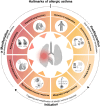Adjuvant-independent airway sensitization and infection mouse models leading to allergic asthma
- PMID: 39157265
- PMCID: PMC11327155
- DOI: 10.3389/falgy.2024.1423938
Adjuvant-independent airway sensitization and infection mouse models leading to allergic asthma
Abstract
Asthma is a chronic respiratory disease of global importance. Mouse models of allergic asthma have been instrumental in advancing research and novel therapeutic strategies for patients. The application of relevant allergens and physiological routes of exposure in such models has led to valuable insights into the complexities of asthma onset and development as well as key disease mechanisms. Furthermore, environmental microbial exposures and infections have been shown to play a fundamental part in asthma pathogenesis and alter disease outcome. In this review, we delve into physiological mouse models of allergic asthma and explore literature reports on most significant interplays between microbial infections and asthma development with relevance to human disease.
Keywords: adjuvant-free; allergic asthma; microbial infection; mouse model; natural allergen; sensitization.
© 2024 Radhouani and Starkl.
Conflict of interest statement
The authors have no commercial affiliation or relationships with any organization or entity with a financial interest to declare and did not receive any financial support for the research, authorship, and publication of this article.
Figures


Similar articles
-
Respiratory viral infections as promoters of allergic sensitization and asthma in animal models.Eur Respir J. 2002 Feb;19(2):341-9. doi: 10.1183/09031936.02.00254302. Eur Respir J. 2002. PMID: 11866016
-
Anti-IgE efficacy in murine asthma models is dependent on the method of allergen sensitization.J Allergy Clin Immunol. 2001 Jun;107(6):1025-33. doi: 10.1067/mai.2001.115625. J Allergy Clin Immunol. 2001. PMID: 11398080
-
Do mouse models of allergic asthma mimic clinical disease?Int Arch Allergy Immunol. 2004 Jan;133(1):84-100. doi: 10.1159/000076131. Epub 2004 Jan 12. Int Arch Allergy Immunol. 2004. PMID: 14726635 Review.
-
Effects of concentrated ambient particles and diesel engine exhaust on allergic airway disease in Brown Norway rats.Res Rep Health Eff Inst. 2009 Nov;(145):5-55. Res Rep Health Eff Inst. 2009. PMID: 20198910
-
A narrative review on asthma and pest sensitization (cockroach, mouse and rat allergens): a social issue besides the medical problem.J Asthma. 2023 Oct;60(10):1800-1808. doi: 10.1080/02770903.2023.2200844. Epub 2023 Apr 23. J Asthma. 2023. PMID: 37042228 Review.
References
Publication types
LinkOut - more resources
Full Text Sources

